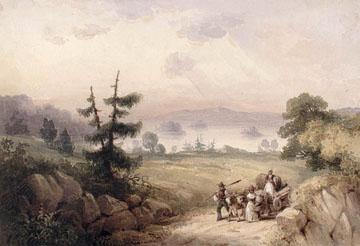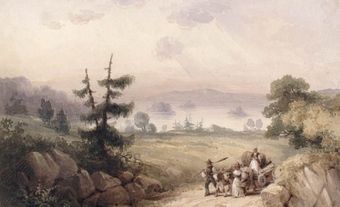Loyalists were American colonists who remained loyal to Britain during the American Revolution (1775–83). Tens of thousands of Loyalists migrated to British North America. Most of them went to the Maritime provinces. The Loyalists left a long-lasting legacy on Canada. They influenced politics and culture in what would become Canada.
(This article is a plain-language summary of Loyalists. If you are interested in reading about this topic in more depth, please see our full-length entry, Loyalists in Canada.)

The Loyalists and the American Revolution
The Loyalists were against the American Revolution. They wanted to remain with Britain. Many of them fought for Britain and wanted to remain a part of the British Empire. Many of them did want change though. They wanted the colonies to have more power. But they thought that revolution was dangerous and wrong.
Who were the Loyalists?
The Loyalists came from many different backgrounds. They included landowners, farmers, tradespeople and labourers. Some had family and business links to Britain. Others were part of minority groups and did not have much power in American society. They hoped that Britain could help them. These included people who had not lived in the colonies for a long time and did not speak English. A large percentage of colonists were not from Britain or Ireland. Also, many Indigenous peoples supported Britain. They did not trust the Americans. And many African Americans supported Britain. They thought Britain would protect them and free them from slavery. The British promised enslaved people their freedom if they fought in the British military. Loyalists were also promised land.
The Loyalists in the Colonies
Loyalists faced many hardships. They lost their rights. They lost their property. They were arrested and put in prison. Many suffered from violence.
About 19,000 Loyalists served with the British military. Thousands of Indigenous people also fought beside the British. Tens of thousands of Loyalist civilians lived in New York. New York was a center of Loyalism. Thousands of Loyalist refugees fled there. They also escaped to camps in Quebec. In total, about 80,000 to 100,000 Loyalists fled. Many of them went to Canada.
Loyalists in Canada
Between 1783 and 1784 about 30,000 Loyalists went to the Maritime provinces. Most of them first went to Nova Scotia. So many went to Nova Scotia that Britain created the colonies of New Brunswick and Cape Breton. Dividing Nova Scotia made it easier to govern. About 10,000 Loyalists fled to what is now called Quebec and Ontario. In 1791, these territories were divided by the Constitutional Act. They were called Upper Canada (Ontario) and Lower Canada (Quebec). About 7,500 Loyalists went to Upper Canada. Haudenosaunee Loyalists went to Upper Canada too. They were given land on the Grand River by the British.
Black Loyalists
About 3,500 Black Loyalists went to the Maritimes. Some of the Loyalists were free. Many of them were enslaved. The Loyalists brought the people they enslaved with them. Slavery was still legal in Canada. The free slaves were promised land by Britain. The land was not very good for agriculture. Most of the Black Loyalists settled near Shelburne, Digby and Halifax. The Black Loyalists faced a lot of discrimination. Many of them eventually went to Sierra Leone to start a new colony.

 Share on Facebook
Share on Facebook Share on X
Share on X Share by Email
Share by Email Share on Google Classroom
Share on Google Classroom


